Cleaning spray paint off concrete may seem like a difficult task, especially when you want to restore your concrete surface back to its original state. However, with the right tools and techniques, it’s entirely possible to achieve this and ensure the integrity of the underlying material.
In this comprehensive guide, we will walk you through some tried and tested methods to get rid of undesired spraying of paint from concrete substrates. Whether you’re dealing with a small graffiti tag or a large paint spill, the steps outlined here will provide you with a clear path to a clean, paint-free surface.
First, gather your supplies. You will need safety equipment such as protective gloves and goggles, as the paint remover is especially formulated for use on concrete materials. Additionally, having a pressure washer or a scrub brush, along with a suitable cleaning solution, will greatly assist in the removal process.
Before you begin, it’s important to assess the degree of overspray and possible structural damage to the concrete. This helps identify the best removal method. For smaller areas, a targeted application of the paint stripper followed by gentle scrubbing with a brush may suffice. However, larger areas or stubborn stains may require multiple applications or the use of a pressure washer.
Once you’ve prepared the area and applied the paint stripper, allow it to penetrate the paint for the recommended amount of time. This will vary depending on the product you’re using, so be sure to follow the instructions provided. After the paint has softened, use a scrub brush or pressure washer to agitate the surface and loosen the paint. Take care not to apply excessive force, as this could damage the concrete.
As you work through the removal process, periodically wash the area with clean water to eliminate any loosened paint and debris. This will help you assess the progress and ensure that you’re effectively removing the spray paint. If needed, repeat the application of the paint stripper and continue scrubbing until the surface is clean.
Once the spray paint is removed, thoroughly rinse the concrete surface to remove any traces of the paint stripper or cleaning solution. Allow the area to dry completely before assessing the results. In some cases, a second round of cleaning may be necessary to achieve the desired outcome.
With patience and the right techniques, can successfully clean spray paint off existing concrete walls and restore them to their original state.
By following this detailed guide, you’ll be equipped with the knowledge and confidence to tackle any unwanted spray paint on your concrete surfaces.
Before You Begin
Before embarking on the paint removal process, it is of utmost importance to prioritize safety precautions. Always make sure to equip yourself with the necessary protective gear, including sturdy gloves, a reliable face mask, and safety glasses. These essential items will safeguard your skin, lungs, and eyes from the potentially harmful chemicals found in both the paint and the cleaning solutions.
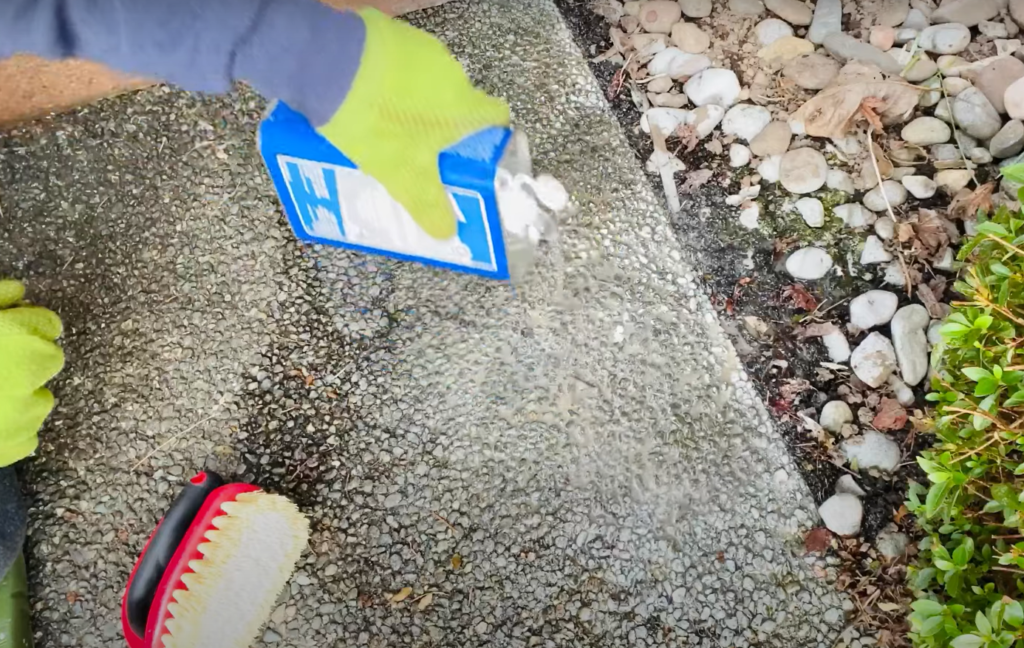
Furthermore, it is strongly advised to ensure that the area in which you are working is adequately ventilated, especially if you opt for chemical-based paint strippers. Proper ventilation will help minimize any potential inhalation of fumes and maintain a healthier environment.
Moreover, it is highly recommended to conduct a small-scale test of the chosen paint removal method on an inconspicuous area of the concrete surface. This precautionary step will allow you to assess the method’s effectiveness while ensuring that it does not cause any undesirable damage to the overall integrity of the concrete.
Lastly, but certainly not least, it is crucial to keep children and pets at a safe distance from the work area throughout the entire paint removal process. This precaution will avoid causing any accidental exposure to the cleaning materials, ensuring the well-being of your loved ones.
By diligently following these safety measures, you can confidently proceed with the paint removal process, knowing that you have taken all necessary precautions to protect yourself, your surroundings, and those around you.[1]
What You’ll Need
To effectively and efficiently remove spray paint from concrete, it is crucial to have the right tools and materials readily available. Here’s a comprehensive list of what you’ll need to tackle this task successfully:
- Paint Stripper: Select a paint stripper specifically designed for concrete surfaces. Ensure that you carefully follow the label directions to guarantee its compatibility and safety.
- Scrub Brush: Opt for a stiff-bristled scrub brush to effectively agitate the paint and assist the stripper in penetrating through the layers. The bristles’ firmness will help loosen and break down the paint particles for easier removal.
- Putty Knife or Scraper: Keep a putty knife or scraper handy to scrape off the loosened paint effectively. This tool will come in handy for removing any stubborn or hard-to-reach paint spots.
- Pressure Washer: If available, a pressure washer can be an incredibly useful tool for tackling resistant paint stains. When using a pressure washer, exercise caution and ensure that you follow the manufacturer’s guidelines for proper and safe usage.
- Safety Gear: Prioritize your safety by wearing essential protective gear. Invest in safety glasses to shield your eyes from any potential splashes or debris. Rubber gloves are crucial for safeguarding your hands from chemical exposure, and a mask or respirator will protect you from inhaling any harmful fumes or particles.
- Bucket and Water: Have a bucket of water ready for mixing the paint stripper if required, and for cleaning up the area after the paint removal process. This will help you maintain a clean and organized workspace throughout the task.
- Absorbent Material: Prepare some absorbent material such as cat litter, sawdust, or absorbent towels. These materials will be useful for soaking up any leftover paint or stripper residue before proper disposal. By using absorbent materials, you can minimize the risk of paint or chemicals seeping into the ground or causing environmental contamination.
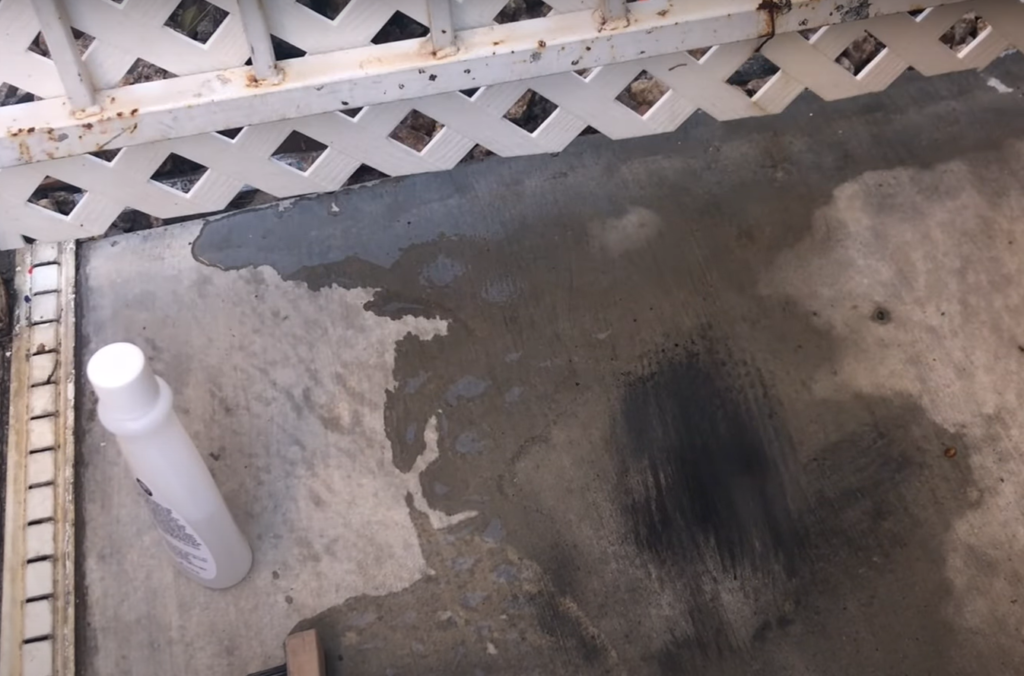
Remember, it is crucial to always follow the manufacturer’s instructions when working with any chemical-based products. If you ever feel uncomfortable or unsure about handling these materials, don’t hesitate to seek assistance from a professional who can ensure the task is completed safely and effectively.[1]
Instructions
Put on Your Protective Gear
Before you begin the actual paint removal process, ensure that you are properly attired in your protective gear. Start by putting on your safety glasses, which will shield your eyes from any stray paint particles or chemicals that might get splashed around during the process. Next, put on your rubber gloves to protect your skin from coming into direct contact with the paint stripper, which can cause irritation or burns. Remember to wear a mask or respirator to safeguard your lungs from inhaling any potentially harmful fumes from the paint or the stripper. Lastly, if you’re working in an area where there might be a possibility of paint splashes, consider wearing an apron or old clothes that you don’t mind getting dirty. Safety should always be your priority when handling chemical-based products.
Remove Excess Dirt From the Area
Before applying the paint stripper, it’s important to ensure that the concrete surface is free from excess dirt and loose particles. Any grime or debris present may hinder the effectiveness of the stripper in penetrating the layers of paint. To clean the area, use a broom or a brush to sweep away loose dirt. For stubborn grime, consider using a pressure washer or a hose with a high-pressure nozzle to rinse the concrete. Allow the area to dry completely before proceeding with the next step. This pre-cleaning process will not only promote better adhesion of the paint stripper but also prevent the unwanted spread of dirt during the scrubbing process.
Prepare Your Buckets
Now that your work area is clean and dry, it’s time to prepare your buckets. If your chosen paint stripper requires mixing, fill one bucket with the specified quantity of water and then slowly add the paint stripper, stirring gently until it’s fully dissolved. Always refer to the label for exact measurements and mixing guidelines. Use a separate bucket for clean water, which will be used for rinsing your scrub brush or putty knife during the paint removal process.
Please remember to set these buckets aside, out of reach of children and pets, before starting the paint removal.Scrub the Spray Paint With Dish Soap and Water
If the paint stains are not too old or deep-seated, a good scrubbing with dish soap and water can effectively remove them. Start by mixing a few drops of dish soap in a bucket of warm water. Soak your scrub brush in this soapy solution, then vigorously scrub the painted area. The soap acts as a mild abrasive, helping to break up the paint, while the scrub brush’s bristles get into the concrete’s pores to lift the paint. Remember to frequently rinse your brush in the bucket to remove the paint particles and keep the bristles effective.
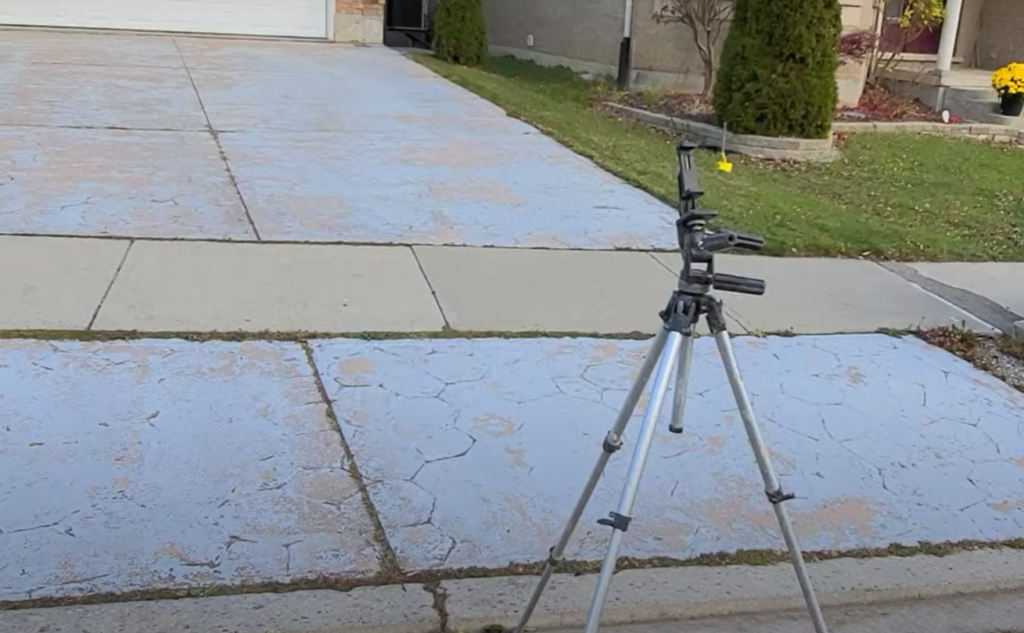
Once you’ve scrubbed the entire area, rinse it thoroughly with clean water to remove any soap residue. If there’s still paint remaining, you may need to repeat the process or proceed with a stronger method like a paint stripper.
Apply Graffiti Removal Spray
If scrubbing with dish soap and water wasn’t enough to remove the stubborn spray paint, you may need to step up to a graffiti removal spray. These products are specially formulated to break down the bonds within the spray paint, enabling it to be scrubbed away more easily. To apply, first shake the can well, then spray a generous amount directly onto the painted area. Allow the product to soak in for a few minutes – some particularly stubborn paints may require up to 10 minutes of soak time. Don’t let the graffiti remover dry out, though; if it’s starting to dry, apply a bit more. Always follow the specific instructions on the graffiti removal spray you’re using to ensure effective results.
Scrub Vigorously With a Brush
Once the graffiti removal spray has been given ample time to soak, it’s time to get to work with your scrub brush. Use firm, circular motions to scrub the treated area thoroughly. The mixture of the graffiti removal spray and your vigorous scrubbing should start to break down and lift the spray paint from the concrete. It’s important to maintain a steady pressure, but avoid being too aggressive to prevent damage to the concrete’s surface. Rinely your brush in the bucket of clean water intermittently to remove the paint particles and to keep the bristles effective. After scrubbing, you should start to see the spray paint fading or coming off. If the paint still remains, you might need to reapply the graffiti remover and scrub again.
Rinse With Clean Water
After the scrubbing process, it’s crucial to rinse the area thoroughly with clean water. This step removes any leftover graffiti remover, loosened paint particles, and residue. Use a garden hose or a pressure washer, making sure to cover the entire treated area. Be cautious of runoff; both the paint and graffiti removal spray can be harmful to plants and certain surfaces. As you rinse, you may notice that more paint is coming off – this is a good sign that your efforts are working. Continue rinsing until all the soap and loosened paint are washed away. Allow the concrete to dry naturally, and then assess if any spray paint remains. Repeat the graffiti remover application and scrubbing steps if necessary, followed by another thorough rinse.[3]
Other Methods
Use Graffiti Remover
If previous methods haven’t worked, it might be time for a heavy-duty solution – a graffiti remover. This strong product breaks down spray paint, making it easier to wash away.
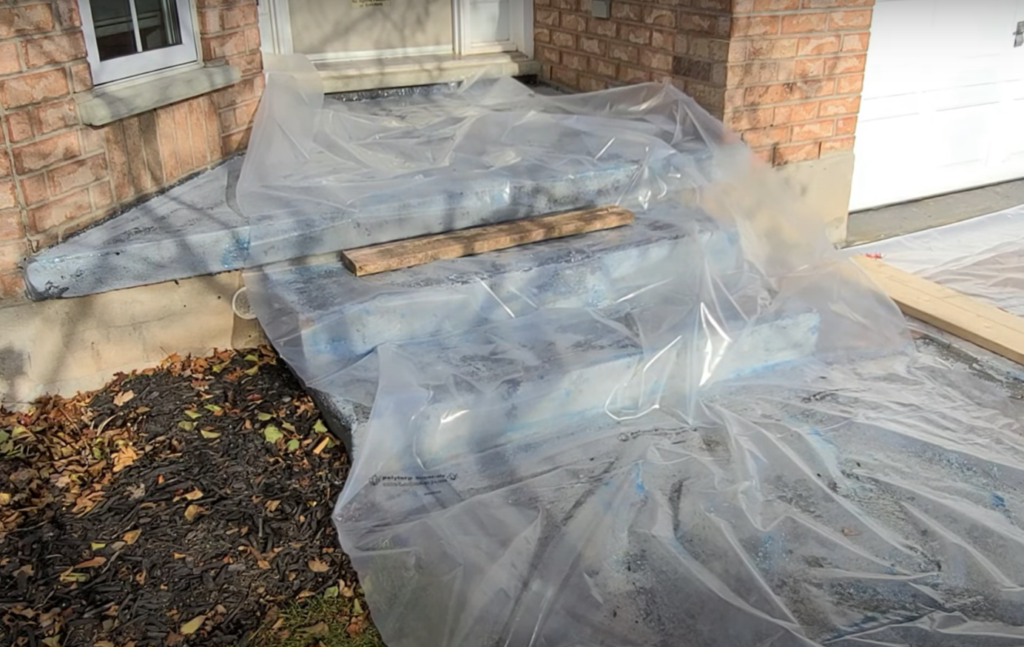
Apply a small amount to a rag or directly on the painted area, let it sit, then scrub with a stiff brush. Rinse thoroughly with water. Remember to wear gloves, eye protection, and work in a well-ventilated area. Always follow the instructions on the package.
Use Paint Thinner or Stripper
For stubborn cases where spray paint won’t budge, using a paint thinner or stripper is your best option. These solvents break down paint layers, making removal easier. Apply the thinner or stripper generously to the stained area, wearing protective gloves. Let it sit for several minutes to penetrate and soften the paint. Scrub the area with a stiff brush, applying pressure. Rinse thoroughly with water. Repeat if needed. Note that these chemicals should be handled carefully. Follow instructions and dispose of used materials responsibly.
Use TSP
Trisodium Phosphate, or TSP, is effective for removing stubborn spray paint from concrete. TSP is a heavy-duty cleaner used to prep surfaces for painting. To use, mix half a cup of TSP with two gallons of hot water. Wear protective gloves and eyewear as TSP is a strong chemical. Soak a stiff-bristled brush in the TSP solution and scrub the spray-painted area.
Repeat until the spray paint is gone. Follow manufacturer’s instructions and dispose of leftover solution responsibly.Use a Power Washer
For stubborn spray paint stains, a power washer can be effective in removing paint from concrete. Set the device to a medium pressure setting to avoid damaging the concrete. Start spraying from a distance and gradually move closer if needed, aiming the water jet at an angle. Be cautious not to remove any sealant on the concrete surface. Use a plastic sheet or tarp to protect surrounding areas. Once complete, allow the area to fully dry before assessing if further paint removal is necessary. This method may require renting or purchasing a power washer. Always follow the manufacturer’s instructions for safety and effectiveness.
Use a Sandblaster
For tough spray paint stains, a sandblaster is a highly effective method. It propels fine abrasive material at high velocity to remove spray paint from concrete.
To use a sandblaster, fill the tank with sandblasting media, connect the hose and wand, and aim at the stain. Keep a reasonable distance to prevent concrete damage. Gradually move the wand closer until you find the right distance for effective paint removal.
Ensure proper ventilation and wear protective gear like a mask, goggles, and gloves to shield from sand particles. Note that sandblasting can rough surfaces, so it’s best for stubborn stains as a last resort.
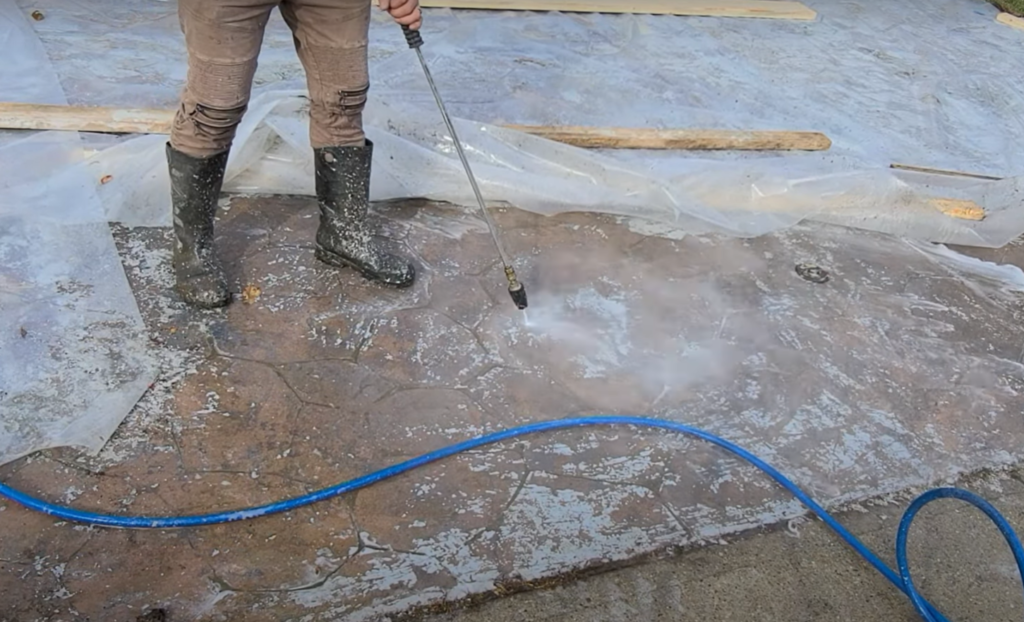
Follow the manufacturer’s instructions, or consider hiring a professional to ensure safety and avoid unintended damage to the concrete.
Use an Angle Grinder
When all other methods fail to remove spray paint, an angle grinder can be a last resort. It effectively grinds down and removes the top layer of concrete, along with the paint. Keep in mind that this alters the appearance, making it smoother and potentially lighter than surrounding areas. To use, fit the grinder with a diamond cup wheel and wear safety gear. Apply steady pressure in a small circular motion until the paint is gone. Afterward, rinse the area thoroughly. Try other alternatives first, as this method is invasive. Follow manufacturer’s instructions for safety. Consider hiring a professional to avoid concrete damage.[2]
FAQ
Does spray paint come out of concrete?
Yes, spray paint can be removed from concrete surfaces. While it may seem challenging, there are various effective methods and tools available. These include using paint thinners or strippers, Trisodium Phosphate (TSP), power washing, sandblasting, and an angle grinder.
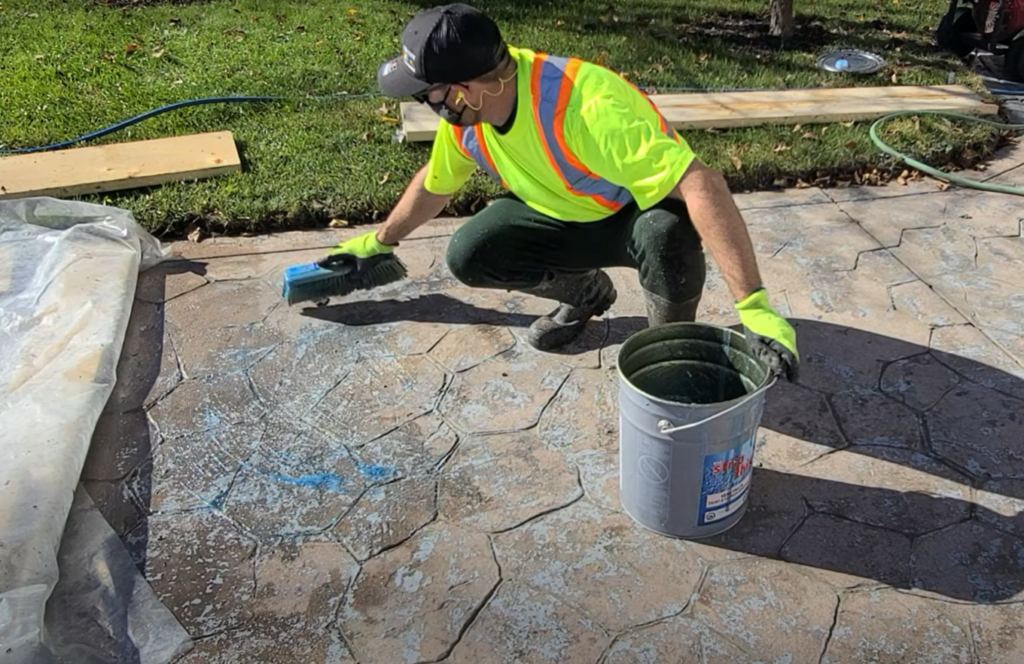
Start with the least invasive methods to avoid altering the concrete surface. Follow the manufacturer’s instructions and wear appropriate safety gear. With patience and repetition, the spray paint will come off the concrete.
Will vinegar remove spray paint from concrete?
Vinegar, a versatile household staple, can remove spray paint from concrete. The acetic acid in vinegar softens the paint, making it easier to scrape off. To use this method, apply white vinegar onto the stained area and let it sit for at least 15 minutes. Then use a stiff-bristled brush to scrub off the paint. Rinse the area with water and repeat as necessary. Keep in mind, this method may take more time and be less effective for larger or older stains. For stubborn stains, try other methods.
How do you remove spray paint from concrete without chemicals?
You can remove spray paint from concrete without chemicals, but it may take more time and effort. A pressure washer is effective for lifting and removing paint with water force. Alternatively, you can use warm water and dish soap. Wet the stained area, apply dish soap, scrub with a brush, let it sit for 10-15 minutes, rinse, and repeat if needed. For larger or older stains, this method may be less effective. Remember to wear protective gear.
What will remove paint from concrete?
Different methods can remove paint from concrete efficiently, with varying effectiveness and impact on the surface. Chemical paint strippers like Methylene Chloride and N-Methyl-2-pyrrolidone (NMP) can dissolve paint, making it easier to scrape or wash off. A more eco-friendly option is a soy-based gel paint stripper, which may take longer to work. Trisodium Phosphate (TSP) is effective for stubborn stains. Physical methods include power washing, sandblasting, and using an angle grinder. Vinegar and warm water with dish soap can work for smaller or newer stains. Follow manufacturer instructions and wear safety gear when using chemical solutions. For aggressive methods, consider hiring professionals to prevent unintentional damage to the concrete.
What is the fastest easiest way to remove paint on concrete?
The best way to remove paint from concrete depends on the size and age of the stain. For smaller and newer stains, a solution of warm water and dish soap can be effective. Apply the mixture, then scrub with a stiff-bristled brush. For larger or older stains, a chemical paint stripper may be the most efficient method. These solutions soften and dissolve paint, making it easy to scrape or wash away.
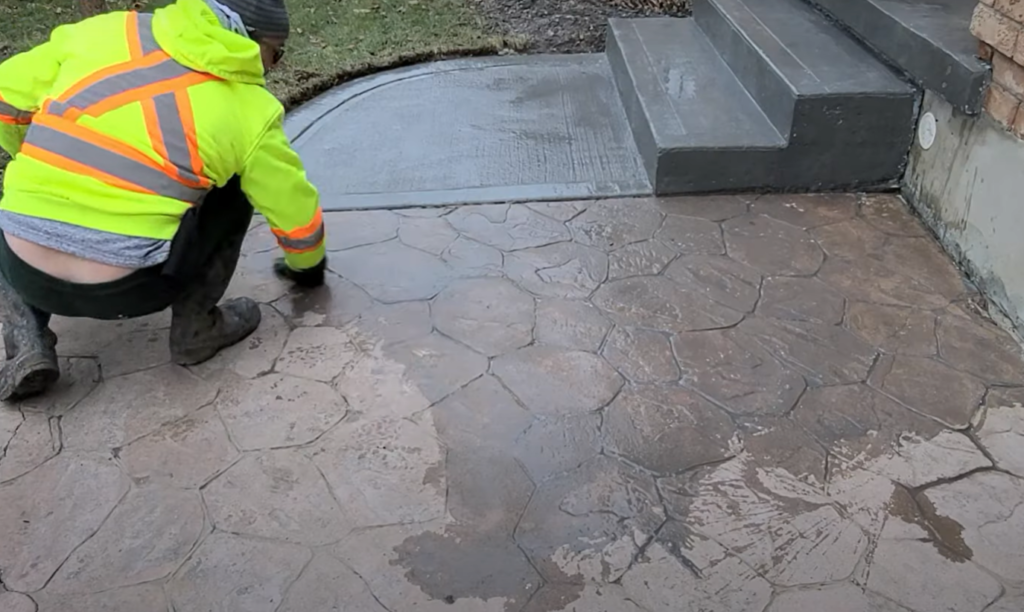
Follow safety guidelines and manufacturer’s instructions when using these products. Power washing can also be effective, especially for larger outdoor areas, but use caution to prevent concrete damage. The best approach depends on the stain’s size, age, location, and safety/environmental considerations.
Can you remove dried paint from concrete?
Dried paint can be removed from concrete surfaces with some effort and patience. Effective methods include using a chemical paint stripper or Trisodium Phosphate (TSP) to break down the paint for easier removal. Power washing or using an angle grinder are other options, but be cautious as they may alter the concrete surface. Follow manufacturer’s instructions and wear safety gear. Removing dried paint may require multiple attempts.
Useful Video: How to Remove Paint from Concrete
Conclusion
Removing spray paint from concrete can be a challenging but surmountable task. There are various methods available that can help you tackle the job effectively. The approach you choose will depend on factors such as the size, age, and nature of the paint stain, as well as your personal safety and environmental considerations.
For smaller and newer stains, you may find that household items like vinegar or a dish soap solution are sufficient to remove the paint. However, for larger or older stains, you might need to resort to more potent chemical strippers or physical methods such as power washing or sandblasting.
When using chemical solutions, it is crucial to prioritize safety. Always wear appropriate protective gear and strictly adhere to the manufacturer’s instructions. Patience, persistence, and a methodical approach are key to successfully eradicating even the most stubborn paint stains from your concrete surfaces.
Remember, taking the necessary precautions and following the right techniques will ensure not only the removal of the paint but also the preservation of the integrity of your concrete.
References:
- https://www.thespruce.com/how-to-get-spray-paint-off-concrete-7567736
- https://prudentreviews.com/how-to-remove-spray-paint-from-concrete/
- https://todayshomeowner.com/cleaning/guides/how-to-get-spray-paint-off-concrete/


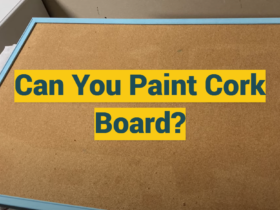
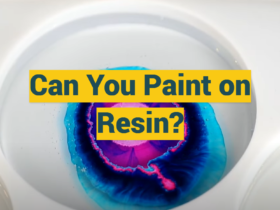
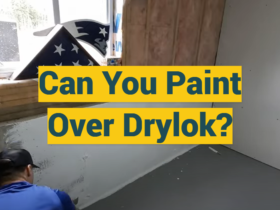
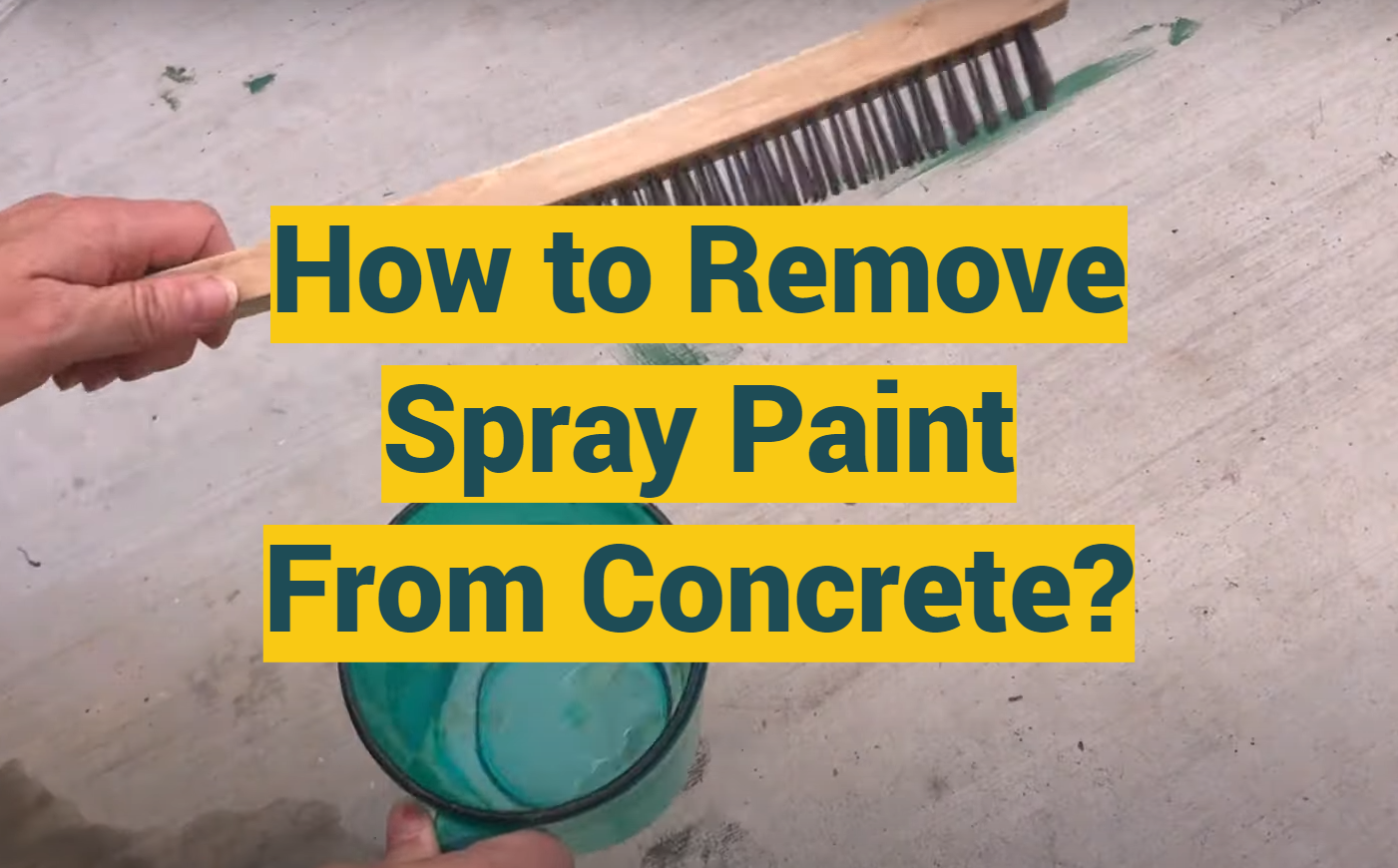
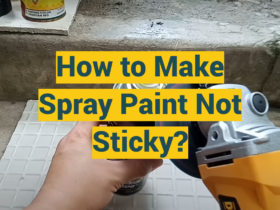
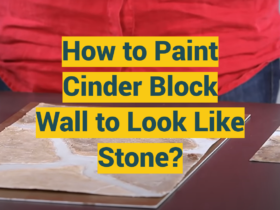

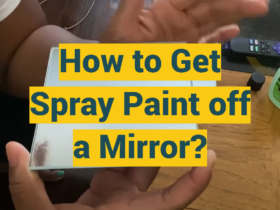
Leave a Review